The Stock Market Gets a Boost as Microsoft Reaches $4 Trillion in Revenue
U.S. equity futures climbed on the back of strong earnings from major technology firms after Wall Street ended the previous session mostly flat. The Federal Reserve’s decision to hold interest rates steady put pressure on Treasuries and left Asian equity futures trading mixed.
Microsoft Corp. reported cloud revenue growth that exceeded expectations, while Meta Platforms Inc. posted stronger-than-anticipated sales. The positive earnings news sent shares of both tech giants higher and boosted U.S. equity futures.
In contrast, futures in Australia and Hong Kong dipped, while Japanese contracts rose, supported by a weaker yen after the dollar strengthened 0.8% on Wednesday. The S&P 500 slipped 0.1%, and 10-year Treasury yields climbed by about five basis points. Though modest, this combined decline marked the worst reaction to a Fed meeting since December.
Federal Reserve Chair Jerome Powell indicated that no decision has been made regarding potential rate cuts in September. He described the U.S. labor market as “solid” but acknowledged that inflation remains above the central bank’s 2% target.
The market’s subdued reaction suggested that investors have scaled back expectations for immediate rate cuts. Instead, optimism stems from resilient economic growth, an earnings boom fueled by artificial intelligence, and the belief that new tariffs may have a limited impact—potentially raising goods prices without significantly affecting services inflation.
“To see a rate cut, the Fed must gain confidence that either future price increases will be temporary and mild or that inflation will continue its downward trajectory over the coming months,” said Bret Kenwell of eToro.
In commodities, copper prices fell after President Donald Trump excluded the most commonly imported form of the metal from his upcoming tariffs. Trump also announced a 25% tariff on Indian exports to the U.S., set to take effect Friday, and hinted at further penalties related to India’s energy trade with Russia.
Additionally, he unveiled a trade deal with South Korea involving a 15% tariff on its exports to the U.S., coupled with Seoul committing to $350 billion in U.S. investments.
Asian markets are expected to watch several key developments, including a Bank of Japan interest rate decision, China’s manufacturing data, and GDP releases from Taiwan and Hong Kong.
The Federal Open Market Committee voted 9-2 on Wednesday to maintain the benchmark federal funds rate within the 4.25%-4.5% range, a stance unchanged in every meeting this year. Governors Christopher Waller and Michelle Bowman dissented, favoring a 25-basis-point rate cut.
Following the announcement, money markets reduced expectations for rate cuts in 2025. Traders now assign less than a 50% probability of a September cut, while the likelihood of an October reduction dropped to about 85%, down from near certainty before Powell’s remarks.
“The next two months of economic data will be critical,” said Ashish Shah of Goldman Sachs Asset Management. “We see the possibility of the Fed resuming its easing cycle in the fall if tariff-driven inflation proves less severe than feared or if the labor market starts to weaken.”
Employment data suggested steady, though slower, hiring. Private-sector payrolls increased by 104,000 in July, according to ADP Research, surpassing economists’ median forecast of 76,000 jobs.
Looking ahead, the Bureau of Labor Statistics will release the July employment report on Friday. Economists expect it to show a slowdown in job growth and a slight uptick in unemployment.
Meanwhile, the U.S. economy expanded at an annualized pace of 3% in the second quarter, according to preliminary government figures released Wednesday. Despite the strong quarterly showing, overall growth for the first half of 2025 averaged 1.25%, roughly one percentage point slower than the 2024 pace.
In summary, while robust tech earnings helped lift U.S. equity futures, the Federal Reserve’s decision to hold rates and cautious comments from Powell signaled that monetary policy adjustments may not come as soon as previously anticipated. Markets will closely watch upcoming employment and inflation data for clues on the Fed’s next move.

Subscribe to our newsletter!
As a leading independent research provider, TradeAlgo keeps you connected from anywhere.








